People
‘My Imagination Ran Wild’: Alteronce Gumby on How His Expansive Style Draws Inspiration From Both Picasso and Music Sampling
Gumby's unique synthesis has made him a fast-rising star.
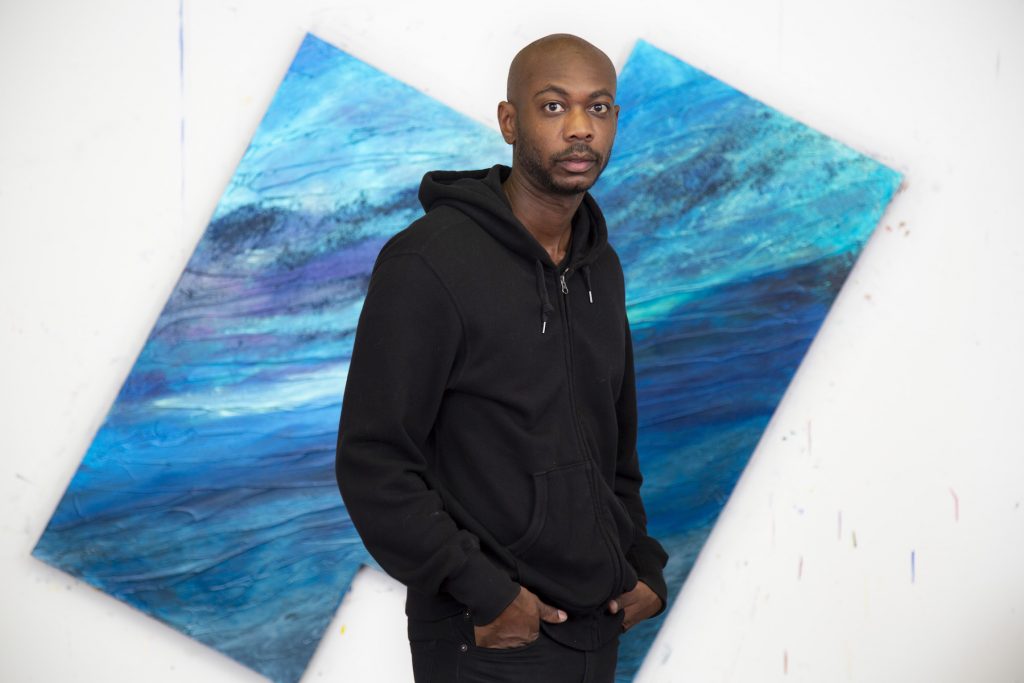
Gumby's unique synthesis has made him a fast-rising star.

Folasade Ologundudu

This article is part of a series of interviews by Folasade Ologundudu exploring the evolving conversation about abstract art among Black artists across different generations.
Alteronce Gumby has had quite a year.
After closing his highly successful dual-site exhibition, “Somewhere Under the Rainbow/The Sky Is Blue and What Am I,” this past summer at False Flag and Charles Moffett galleries, the Yale-trained painter released his first monograph, Colour Is a Beautiful Thing, with contributions by star-making figures Antwaun Sargent and Ashely James, chronicling Gumby’s experimentations in color, form, and texture.
Gumby’s dynamic abstract paintings are rich with context, and Colour Is a Beautiful Thing presents the artist’s musings on the ways in which we interpret and perceive color. Much of Gumby’s work centers around color theory, African American culture, and the history of tonal painting.
In Miami for the 2021 art fairs, the artist also participated in Nicola Vassell Gallery’s first Art Basel presentation, “Color Vaults,” an intergenerational dialogue between Fred Eversley and Gumby about abstraction. While the two artists differ widely in their approach to art-making, each subverts assumptions of color and perception.
In a recent interview, Gumby shared with me his thoughts on the importance of leaving a legacy, the ways in which people make assumptions about his work as a Black abstract painter—and why he has one eyebrow raised at the art world and the newfound success of Black artists.
Talk to me about your upbringing. Where are you from? What are some of the experiences that shaped you as an artist in your formative years?
I was born and raised in Harrisburg, Pennsylvania. I’m the youngest of five. My mother was a minister so I grew up in a church, which definitely made me more aware of my spirituality and believing in things that aren’t seen. I have a lot of faith in my work and my practice.
That may also tie into my fascination with the cosmos. That’s another thing that we as human beings kind of believe is there—but very few of us have actually left this planet. When I look at Rothko, Ellsworth Kelly, Stanley Whitney, or Alma Thomas, I feel as if they’re relating to not only the physical world but also to a spiritual or subconscious level of thinking that is intangible.
I didn’t grow up in an artistic family. I feel like my whole life I’ve been searching for the person that I want to be. As artists, you kind of come to this realization, when you’re working in your studio, that you’re not only trying to figure out a painting; you’re trying to figure out who you are as a human being.
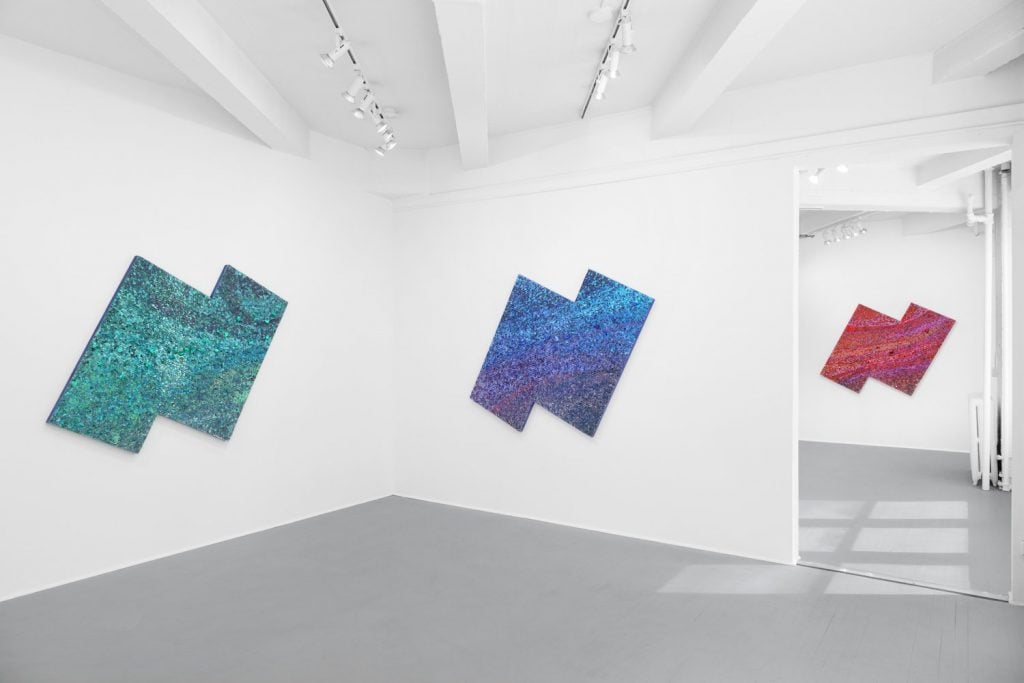
Installation view of Alteronce Gumby, ” Somewhere Under the Rainbow / The Sky is Blue and What am I” at Charles Moffett Gallery. Image courtesy Charles Moffett Gallery.
I’m always interested in how artists come to the art world. What were some of the experiences that led you to pursue art-making as a career?
I was 19 and studying architecture in Harrisburg. A study abroad program came up and I begged my mom and dad to fund me on the trip to Spain.
On the first day in Spain we were on a walking tour of Antoni Gaudí and I was really into the way he thought outside the box in terms of architecture. After that, we had free tickets to go to the Picasso Museum. Before that I had never stepped foot inside of an art museum, and didn’t have a reference for who Picasso was or the impact he had on art and culture. I was mesmerized and taken by his vision for the world and the progression through his artistic practice.
I came back from that trip telling all my friends about Picasso. I actually dropped out of architecture school and moved to New York City!
From that moment, I started having a growing interest in art. A show at the MoMA really opened my eyes to abstraction, to painting, to the New York School. I fell in love with abstract painting. That was the moment I told myself I would like to go back to school to study art. It was at Hunter College, working on my BFA, that I began meeting with artists like Rashid Johnson and Stanley Whitney. I decided that I wanted to pursue a career as an artist.
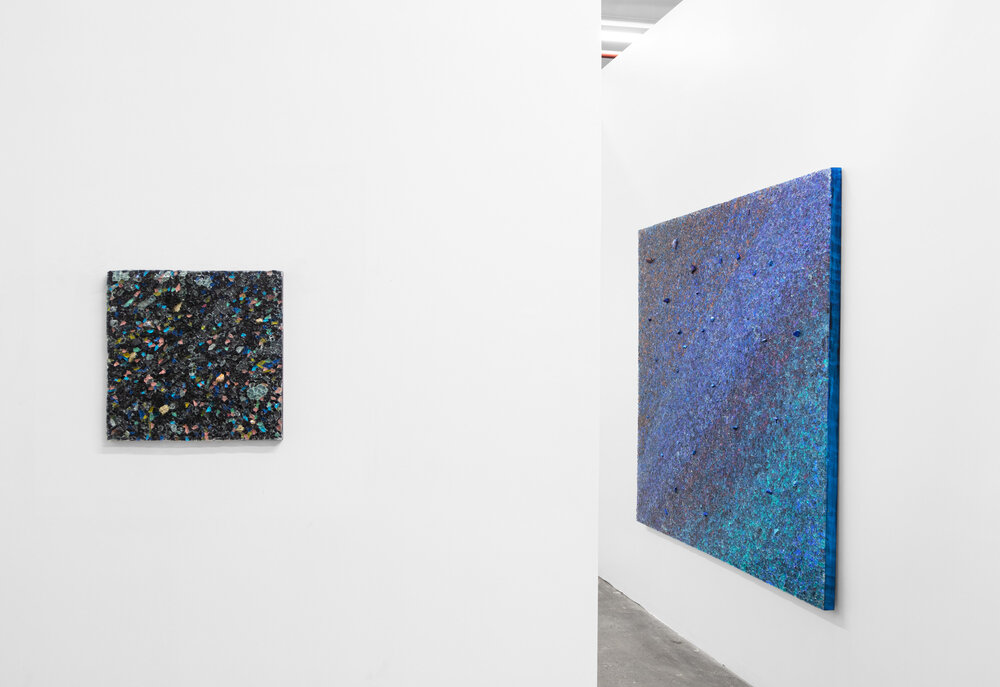
Installation view of Alteronce Gumby, ” Somewhere Under the Rainbow / The Sky is Blue and What am I” at False Flag. Image courtesy False Flag.
What experiences did you have coming into contact with and learning about Black abstract artists in school?
When I was at Hunter College, there wasn’t a lot of teaching about Black abstract artists. I wasn’t seeing any artists in the market that looked like me. In our history class the closest thing you got to abstraction was Basquiat.
I asked one of my professors if there were any contemporary Black abstract artists I could check out and she told me about Jack Whitten, Frank Bowling, Howardena Pindell, Alma Thomas, Stanley Whitney, Mark Bradford. I started seeking these people out. It got to the point where I just started running into them at openings in Chelsea and started asking them if I could go to their studios. From there a kind of mentorship developed. It wasn’t until I got to Yale that I took an Afro-Modernism class.
You’ve often described your artworks as vehicles for travel—most specifically, as spaceships. Why are you interested in this element in your work? What are the larger underlying ideas that you’re trying to work through or bring to life?
I grew up in Central Pennsylvania. It’s a driving culture. Freedom for a teenager who grew up in that type of environment was when you got your own wheels. You could do whatever you wanted within that vehicle. When I’m working on a painting, I’m interested in ideas that lead me to a sense of freedom, whether it’s physically, spiritually, or mentally.
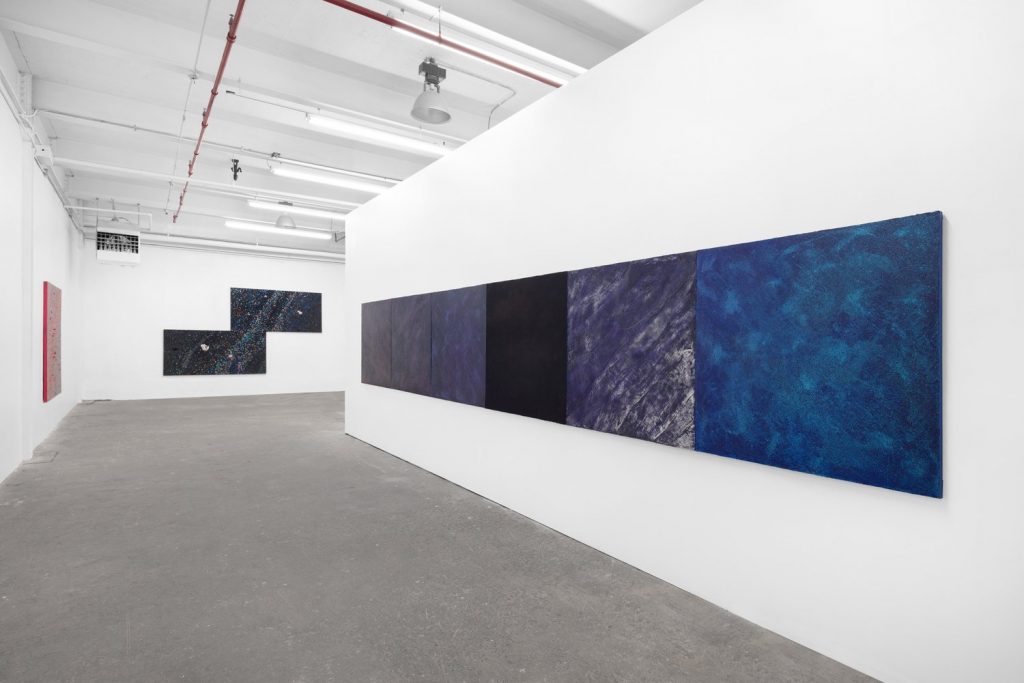
Installation view of Alteronce Gumby, ” Somewhere Under the Rainbow / The Sky is Blue and What am I” at Charles Moffett Gallery. Image courtesy Charles Moffett Gallery.
You’ve talked about the importance of “the unknown.” How do elements of the unknown influence you and the way you work, create, and come up with ideas?
The idea of the unknown keeps me on my toes. It keeps things fresh—not necessarily knowing what’s going to happen when I put two materials together keeps this dimension of playfulness and experimentation alive in a studio. I like that.
Every artist who was an innovator in their craft had to think outside of the box with a sense of curiosity behind their practice so that they actually got to a place where they were in uncharted territory, where they were putting these formulas and equations together.
And they had to have this sense of curiosity about them to keep moving forward and to keep a sense of hunger and curiosity behind their practice so that they actually got to a place where they were in uncharted territory formulating equations together.
How did you arrive at abstraction as a form of creativity?
When I came to New York I ended up going to school for audio production and recording. They trained us so that we could walk into any recording studio and mix music. I grew up listening to nothing but straight R&B and hip-hop and gospel music. That was the first time I listened to the Rolling Stones, to the Beatles. And it was the first time I listened to a lot of jazz.
Listening to all these various genres of music I found references from samples of hip hop songs. I noticed that there was actually a combination of a lot of different genres of music in hip-hop.
So when it came to thinking about abstraction, I could look at a Rothko or a Pollock and I could see Rembrandt, jazz, nature, past memories, future manifestations. My imagination ran wild. I felt like abstraction was limitless. It allowed me to evoke all these various experiences within one object.
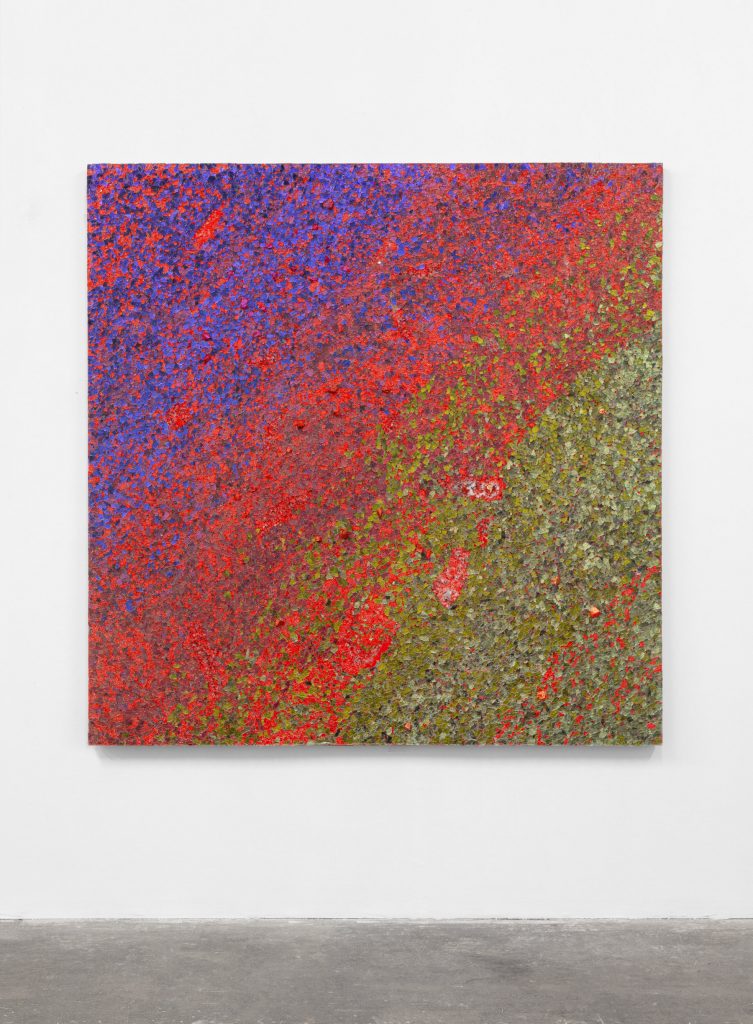
Alteronce Gumby,
Amazing Grace (2021). Image courtesy False Flag.
What function does abstract art play in your life? How does the medium itself serve a function and or purpose in your life to communicate ideas?
Abstraction allows me to think outside the box and have perspectives on a world other than the one I can see, feel, touch, taste, and smell. It opened another way to experience the world. And I’m trying to exercise that sensibility. And I think that, already in my practice within my studio, I’m not necessarily trying to just use the traditional way of thinking about an abstract painting, but to kind of solve an abstract painting.
![Alteronce Gumby, <em>Amazing Grace</em> (2021) [detail]. Image courtesy False Flag.](https://news.artnet.com/app/news-upload/2021/12/alteronce-gumby-amazing-grace-detail.jpeg)
Alteronce Gumby, Amazing Grace (2021) [detail]. Image courtesy False Flag.
Now you see more and more Black artists coming out of school who are hot to the market. I think the visibility is good, but I do have my suspicions about the surge of Black figuration. There were moments I felt pressured to maybe make figurative paintings because I’m a Black person. But I really wanted to stick to my love for what got me involved in art to begin with. I think everyone who is a Black artist right now having success in the art world, I think it’s a great thing—but I do question the market’s motive behind it.
What are some of your thoughts about what’s behind the rise in popularity of Black artists? Why are there such skyrocketing prices for Black art on the secondary market?
I think, historically, everything we’ve touched has turned to gold. Everything Black people touch to turns to gold. I think we’re just magical beings that way. And I think that the art market at large knows that anything Black people innovate and make hot is in some way, shape, or form going to turn a profit.
The market is correcting itself historically for the exclusion of Black artists from the canon. The Black Lives Matter movement and other social justice movements have influenced the art world as much as in has every other industry. I’m happy to see that all the Black talent that was overlooked because of racism is now getting its due today.
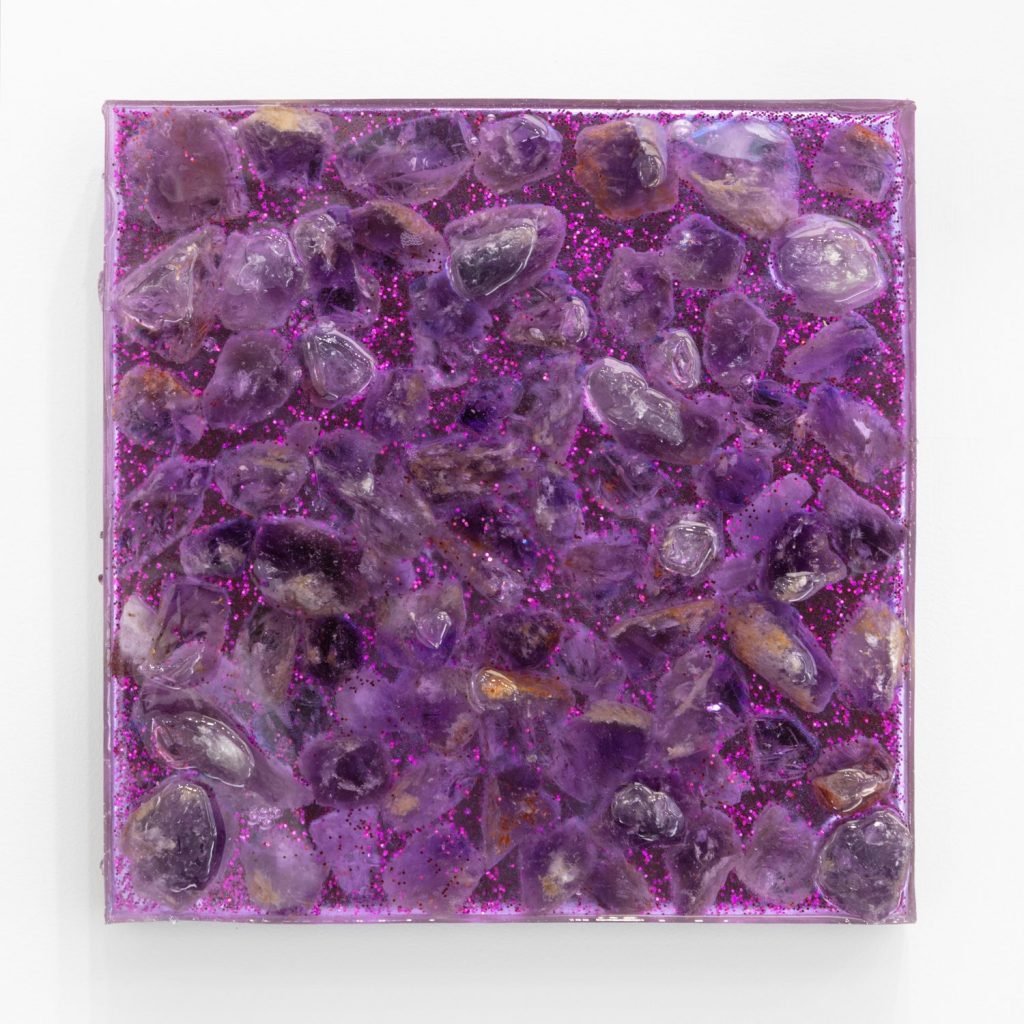
Alteronce Gumby, Purple Rain (2021). Image courtesy Charles Moffett.
Who are some of the artists who’ve inspired you? What is it about them, their practice, their way of thinking that really speaks to you?
Rauschenberg, Rothko, Jack Whitten, Picasso. I think all of these artists were really innovative. They were doing something different. They seem to be habitual risk-takers in their studios and practice and it shows in the work.
For Picasso to do Cubism with Braque—it was a really a way of changing style and looking at the world. Rauschenberg was taking discarded objects from the streets of New York and bringing collage into his paintings. Jack Whitten created his own tool for making a mark. Mark Bradford is another person who uses objects from the streets.
These people were outside thinkers, they weren’t just taking paint out of a tube and a brush and going back to this academic way of thinking of how to make a mark or how to make a painting
To me, [encountering these artists] was almost like coming across like an alien language or looking at hieroglyphics. You can tell it’s manmade but it speaks with this sense of otherness.
That’s something I strive for within my practice: Trying to develop this language for myself to speak to the world.
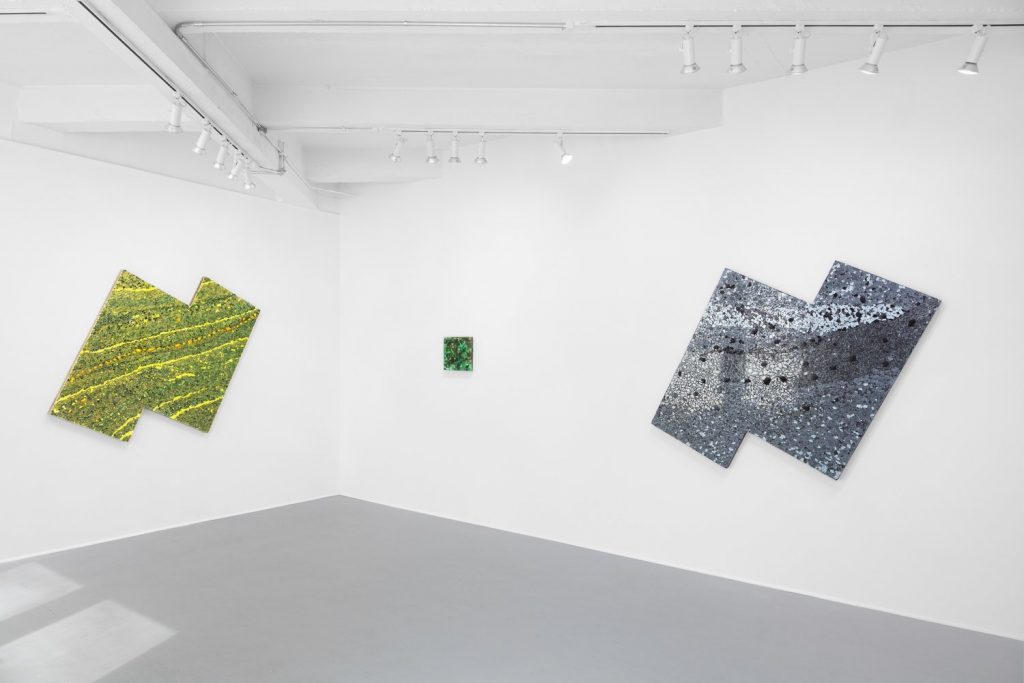
Installation view of Alteronce Gumby, ” Somewhere Under the Rainbow / The Sky is Blue and What am I” at Charles Moffett Gallery. Image courtesy Charles Moffett Gallery.
Can you talk to me a little bit about your experience at Yale? Talk to me about the critique process, and being a Black artist in a historically segregated white space. What was that like for you?
You trying to get the juice! Yale was definitely an experience. You know, there were only a handful of us, artists of color, there. It definitely wasn’t easy being a Black man in a very white space. I will say at Yale, I had an intention in mind going in, of what I wanted from graduate school, and I just kept that intention through my two years there.An
The world was an interesting place back then. The killings of unarmed Black people at the hands of police didn’t help in terms of mental health. The school held town halls and brought in specialists to help guide conversations around race and diversity. The curriculum was changing, the university as a whole was changing, and I was trying to find myself and evolve as an artist at the same time. Overall it was a great learning experience for me.
There were definitely moments where people were putting their own personal perceptions of me as a Black man onto my work and I had to develop a thick skin for how people were talking about my work. But through those conversations, I realized that abstraction, color, and materials is the language through which I speak.
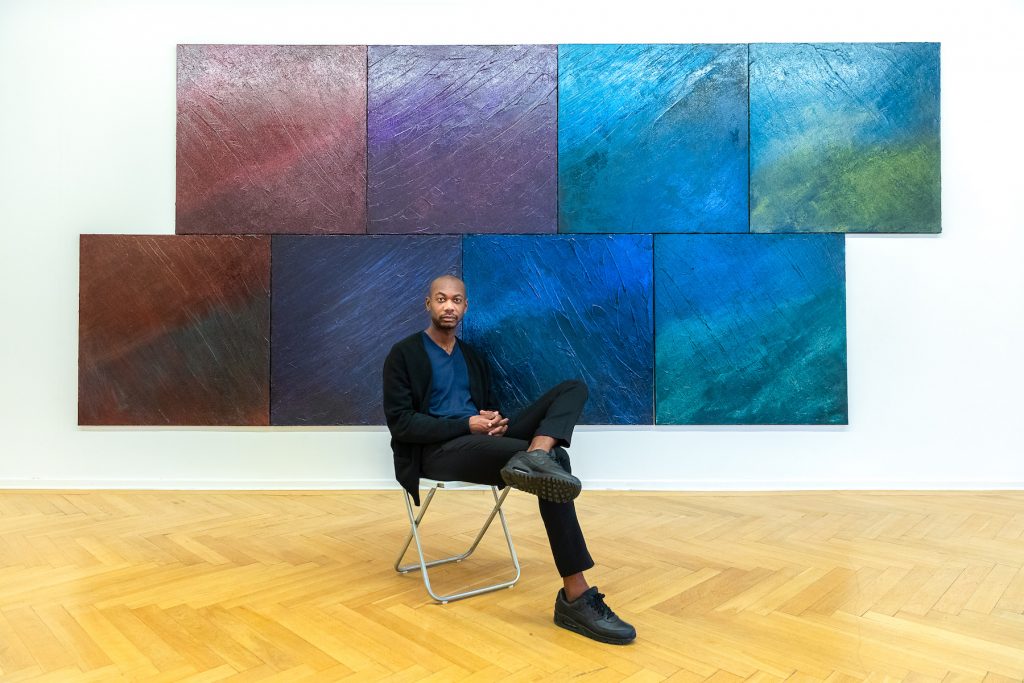
Alteronce Gumby.
Earlier in the interview, we talked a little bit about Black artists who are having a lot of success in their careers right now, but wanting to remain critical about the work at large. So I wanted to ask you about your monograph. It’s your first piece of published work and it features essays by Antwaun Sargent and Ashley James. How did the monograph come to life?
I interviewed Stanley Whitney for Bomb magazine. And I remember asking him, “why aren’t there more Black artists working abstraction?” It seemed like when I was in school, there was not as much text about their story, their contribution. So I asked him and he pointed me to the oral history project that was apart of the Smithsonian. They had interviewed a few Black artists like Jack Whitten, Sam Gilliam, and Alma Thomas.
They were all oral histories. I felt like that aspect of keeping records of one’s story, especially as an artist, especially as a Black artist, is something that’s needed. I wanted to make sure that my history, my story, and my work were being recorded. And I didn’t want to wait for another institution or someone else to come along and give me that opportunity. I wanted to take that power into my own hands.
My monograph came about working on a show with Charles Moffett and False Flag, as a part of that collaboration. It outlines six years of my practice, focused on painting specifically. I wanted to focus on painting for this edition, leaving room for other monographs to be created in the future.
So you’re saying the monograph was made intentionally with a focus on painting so that other books could focus on other parts of your practice?
It leaves the door open. I was at the Jasper Johns retrospective at the Whitney, and as someone who likes to grab the catalogue, I’m in the bookstore and they show me basically an encyclopedia—they have five volumes of Jasper Johns paintings! It’s like a box set. Then there’s another five volumes of Jasper Johns drawings. And then there is another five volumes of Jasper Johns sculptures or prints. And I’m like, “are you shitting me right now?” I think that record that he’s leaving behind that’s so important.